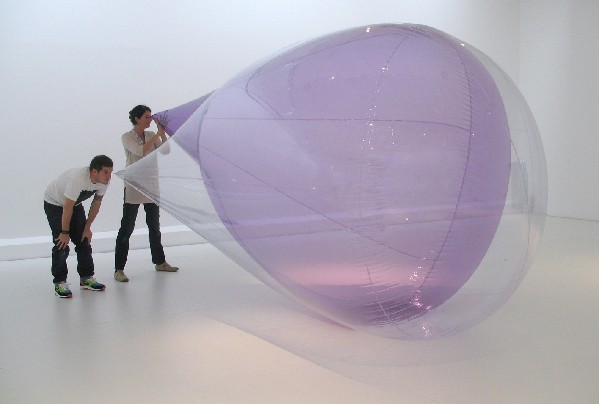
“Swiss Bliss,” a group show curated by Chris Larson, now at Bethel University’s Olson Gallery
Herbert Weber, “papierbaum oder der widerstand der dinge (papertree, or the resistance of things),” digital photograph, 2008. Courtesy of Bethel University and the artist
Bethel University’s Olson Gallery is an airy, sunlit space situated on the second floor of the school’s student center; the exhibition space is one generous room fronted by a bank of windows, looking out onto woods and water. The current group show of work by six Swiss artists, appropriately titled “Swiss Bliss” and curated by artist Chris Larson, complements the verdant view outside, with works which, according to the exhibition’s didactic statement, “resist, subdue, deconstruct, explore, escape, celebrate and critique” the grand landscapes and picturesque Alpine vistas of their native country.
On view is a collection of sculptures, drawings, photography and installation by artists Tobias Brunner, Werner Casty, Christian Herter, Mara Mueller, Martin Walch and Herbert Weber. Despite the stated conceit of the show, the work itself doesn’t feel bound up in any particular national identity at all. If anything, there’s something universal about what’s reflected in these pieces: something to do with the storytelling urge, and with the quixotic tangle of human perception and meaning-making, whose confident overreach is always at odds with the indifference of a world inadequately grasped, too slippery and vast and passing strange for full apprehension by our meager, human senses.
Martin Walch, “Observer,” plastic foil, inflated object, 2009. Photo courtesy of the artist’s website
The installation of the show is such that the pieces on view seem in conversation with one another; but a few stand out. The center of the gallery is dominated by Martin Walch’s monumental, inflated plastic sculpture, “Observer,” which looks a bit like conjoined teardrops – one clear, one a translucent purple – or like a pair of “cones of vision” from a beginning drawing class’s perspective exercises; or like the consonance and dissonance of two separate viewings of the same thing, made manifest.
Along a facing wall is an arrangement of 300 Styrofoam “islands” – stark white, irregularly shaped, with hot pink peeking from behind. The installation reads like an archipelago. According to the exhibition essay, written by Walker Art Center curatorial fellow Yesomi Umolu, each of the cut-outs in Mara Mueller’s “Mountain Lakes 1:1500” represents a different mountain lake in one of the four districts of Switzerland; but they’re removed from their topographical contexts and rearranged into new groupings, with no regard for the lakes’ actual proximity or relation to one another.
Werner Casty, “Engadiner Passagen (tree),” graphite on paper, 2011. Courtesy of the artist’s website
Both these pieces are disorienting and disarming. Walch’s work offers an unsettling, but perfectly apt representation of the bounded and hopelessly incomplete scope of human perception when measured against all that lies “outside the cone.” Mueller’s reconfigured “lakes” whimsically deconstruct the sense of security bestowed by maps and signs.
Along the back wall of the show are a number of photographs and drawings; Herbert Weber’s wry series of photos are especially arresting. Two of them, in particular, catch my eye: In “papierbaum, oder der widerstand der dinge (papertree, or the resistance of things),” a black-and-white photo, a paper box atop stilts sits in a lonely landscape, tree branches affixed and jutting out from the box at all angles. In another, “the tree and me,” a man stands on a hilltop – nothing visible behind him but a dense fog of white – arms outstretched on either side, each hand holding up a wooden board to which a leafless limb is mounted, with another running up his back, above his head; sheets of paper are blown all around, scattered on the ground and caught in the “branches” of his man-made “tree.”
Herbert Weber, “the tree & me,” digital photograph, 2009. Photo courtesy of Bethel University and the artist
The exhibition is quiet but provocative; it’s an intellectually twisty, satisfying collection of work and well worth a visit to the gallery.
“Swiss Bliss,” curated by Chris Larson, featuring work by six Swiss artists – Tobias Brunner, Werner Casty, Christian Herter, Mara Mueller, Martin Walch and Herbert Weber – is on view through December 14, 2012 at Bethel University’s Olson Gallery, 3900 Bethel Dr., St. Paul; 651-638-6400; www.bethel.edu/galleries. Tobias Brunner, from the “Holga Series,” digital print, 2010. Courtesy of the artist’s website.
Recent Content
-
Artsarticle ·
-
Artsarticle ·
-
Artsarticle ·




